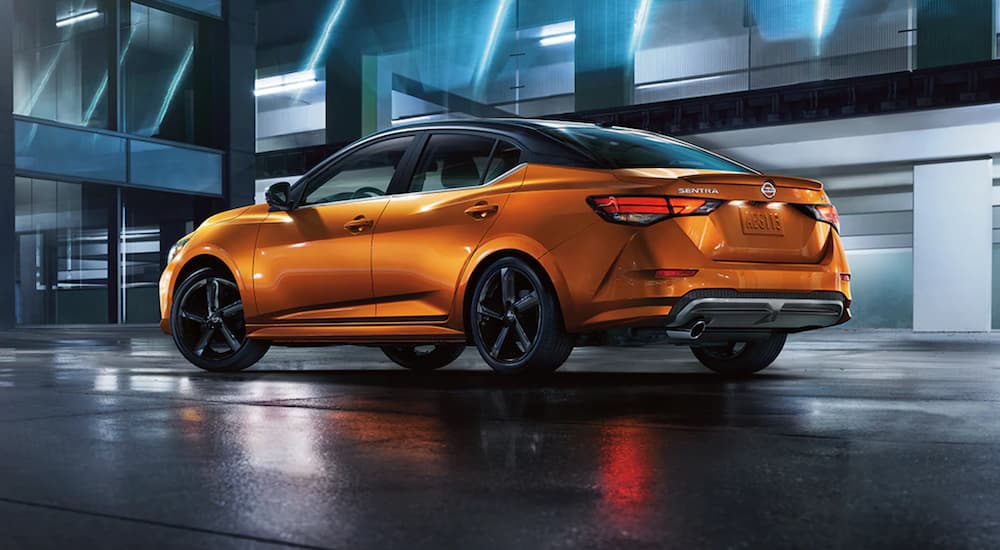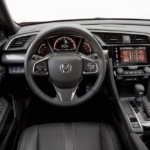How long is your commute to work? Regardless of whether it’s minutes or an hour’s drive, your commute should be enjoyable and, dare we say, even fun. Thanks to automakers like Nissan and Hyundai, more drivers are putting the fun back into their commute by getting behind the wheel of sporty sedans like the Sentra and Elantra. But which model is better if you’re looking for the trifecta – a powerful and efficient sedan that also offers exceptional comfort? Let’s put the models to the test in this 2021 Nissan Sentra vs 2021 Hyundai Elantra comparison.
Performance and Efficiency
While sedans like the Sentra and Hyundai were not always fun to drive, things have drastically changed over the last few decades, and commuters are reaping the benefits. For 2021, Nissan replaces the Sentra’s previous 1.8-liter engine with a more efficient and powerful 2.0-liter four-cylinder engine that sees a 20 percent increase to 149 horsepower and a 17 percent increase in torque to 146 lb-ft. This power pairs exceptionally well with the exclusive Xtronic transmission that seamlessly shifts the Sentra into gear and makes the sedan quick to accelerate and respond.
With plenty of power at your disposal, you’ll find the Sentra is easy to control and steer thanks to the extensive improvements Nissan made to its driving dynamics. These improvements include a new independent rear suspension, a MacPherson strut front suspension, and twin-tube shock absorbers that lessen the blow of every bump in the road. The Sentra also sits lower and wider than its previous model, which gives the sedan more stability. This and the new 2.0-liter engine directly affect the Sentra’s efficiency, with the sedan averaging an estimated 29 MPG in the city and 39 MPG on the highway.
When you start comparing the 2021 Hyundai Elantra with the Sentra, you’ll see only slight differences in power and efficiency. The Elantra is outfitted with a 2.0-liter Atkinson Cycle engine and an intelligent variable transmission that produces 147 horsepower and 132 lb-ft of torque, which is less than the Sentra. For 2021, Hyundai made similar improvements to the Elantra’s design with better proportions and a lower stance that forces its center of gravity lower to deliver better handling and stability. This means you can expect a similar EPA-estimated fuel rating from the Elantra, which averages 33 MPG in the city and 43 MPG on the highway, but that increase in the fuel economy comes at the price of power.

Interior Design and Luxuries
With both the Sentra and Elantra proving their power and efficiency, the next aspect to consider is their interior design and how comfortable you’ll be in the driver’s seat. Nissan’s keen attention to detail pushes the Sentra ahead of the Elantra for 2021. The Sentra’s interior is more luxurious than ever, with high-quality materials that extend from the satin chrome aluminum accents and contrast seat stitching to the D-shaped steering wheel that’s smooth to the touch and gives you a greater sense of control. The Zero Gravity front seats put you in the optimal driving position, while available features like leather seating, heated front seats, and a heated steering wheel take the Sentra’s opulence to the next level.
The Elantra’s interior is one of function and comfort. For 2021, Hyundai repositioned the driver’s seat so that you’re sitting lower in the sedan, which adds confidence and gives you a greater sense of control. Beyond this lower position, the Elantra also has an array of comfort features available across its three-trim lineup. These features range from cloth or leather seating, heated front seats, and a power driver’s seat with lumbar support. Unlike the Sentra, however, you won’t find the luxury of a heated steering wheel, which can truly make your commute easier to manage on those crisp winter mornings.
Technology
Your comfort on your commute to work relies on more than just the interior design of a sedan. The technology you have at your disposal goes a long way to making your drive more enjoyable and safer. This technology extends from connectivity features to safety and driver-assist tools that work to keep you connected and focused while minimizing the potential for distractions and collisions.
Connectivity
Both the 2021 Sentra and the 2021 Elantra offer exceptional technology suites. On the Sentra, this technology starts with one of two combinations: a 4.2-inch digital multi-information driver’s display with a 7.0-inch color touchscreen display or a 7.0-inch digital advanced drive-assist display with an 8.0-inch NissanConnect touchscreen display. Through this suite of technology, you’ll have access to the Bluetooth Hands-Free Phone System and can sync your smartphone using Apple CarPlay or Android Auto integration, which means you can listen to your favorite playlist on the Sentra’s 8-speaker Bose premium audio system.
The Elantra offers similar technology with a digital instrument cluster that’s home to driver-assist alerts, navigational cues, and utilities like speed, mileage, fuel level, and more. The standard 8.0-inch center touchscreen display can be upgraded to a 10.25-inch display that includes wireless Android Auto and Apple CarPlay integration. The Elantra’s wireless smartphone integration is certainly an advantage over the Sentra, but the Elantra doesn’t offer a premium audio system or an immersive listening experience, both of which make a big difference when you spend a lot of time in your car.

Safety and Driver-Assist
Safety is a top priority for Nissan and Hyundai, which is why you’ll find similar safety and driver-assist technology on both the Sentra and the Elantra. The 2021 Sentra offers the most standard safety features in its class, which includes the outstanding Nissan Safety Shield 360. The Safety Shield 360 suite offers advanced driver-assist tools like Automatic Emergency Braking with Pedestrian Detection, Blind Spot Warning, High Beam Assist, Lane Departure Warning, Rear Automatic Braking, and Rear Cross Traffic Alert. These tools, along with standard features like Intelligent Driver Alertness, are designed to enhance your visibility, alert you to potential hazards, and minimize the potential for collisions.
Hyundai includes the SmartSense safety suite on the 2021 Elantra. This suite includes Forward Collision-Avoidance Assist with Pedestrian Detection, Lane Keeping Assist, Lane Following Assist, High Beam Assist, Driver Attention Warning, Blind-Spot Collision-Avoidance Assist, Rear Cross-Traffic Collision-Avoidance Assist, and a Safe Exit Warning. You can enhance the suite by adding optional tools like Parking Collision-Avoidance Assist, Highway Driving Assist, and Smart Cruise Control.
And the Winner Is…
When you start comparing two sedans like the 2021 Nissan Sentra with the 2021 Hyundai Elantra, it’s easy to see many similarities whether you’re looking at performance and efficiency, interior comforts, or connectivity and safety features. The Sentra takes the lead in nearly every category after a stunning redesign in 2021 that gains the sedan even more power and favor in its segment. While its lead may be slight at times, it’s hard to deny the Sentra’s award-winning history.
Which sedan will you choose? As you look at the Sentra and the Elantra, be sure to test drive the models and see how you feel in the driver’s seat and how the sedans align with your driving style and transportation needs. Why? Because when it comes down to it, both models offer everything you need to make your commute enjoyable, relaxing, and safe.



